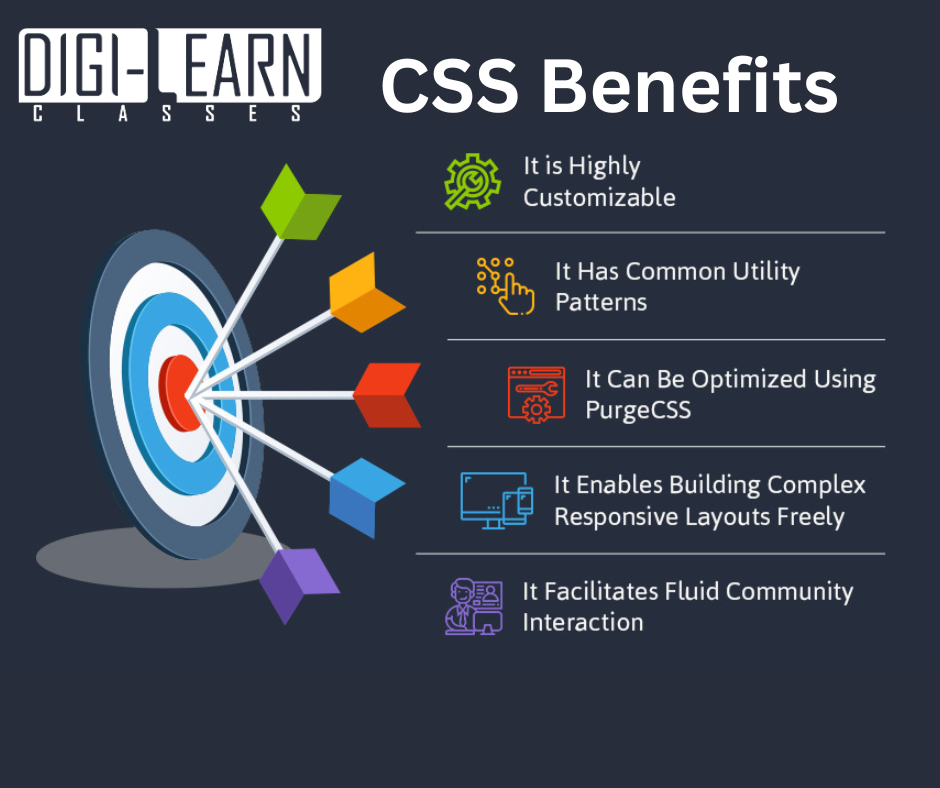
Learn Coding HTML & CSS
Learn coding HTML and CSS is a great way to start building websites. HTML (Hypertext Markup Language) is used to structure the content of a webpage, while CSS (Cascading StyleSheets) is used to define the visual appearance and layout. You can start your coding classes today with digilearn classes. All the programming languages have its own structure, here’s a step-by-step guide to help you get started:
Set up your development environment:
Choose a text editor
You can use any text editor to write HTML and CSS code. Popular choices include Visual Studio Code, Sublime Text, or Atom.
Create a project folder
Set up a folder on your computer to organize your HTML and CSS files.
Learn HTML:
HTML elements
Familiarize yourself with HTML tags and elements, such as headings, paragraphs, links, images, lists, tables, and forms.
Structure
Understand how to structure your content using HTML elements, including the use of headings, sections, divs, and semantic elements like <header>, <nav>, <main>, <article>, <footer>, etc.
Attributes
Learn about HTML attributes and how to use them to add additional information or modify element behavior.
Forms
Explore how to create forms to collect user input, including text fields, checkboxes, radio buttons, dropdowns, and buttons.
Master CSS:
Selectors
Understand how to select HTML elements using CSS selectors, such as element selectors, class selectors, ID selectors, and attribute selectors.
Styling properties
Learn CSS properties like color, background, font, padding, margin, border, and more to style your HTML elements.
Box model
Understand the box model concept, which defines how elements are rendered on the page, including content, padding, border, and margin.
Layout
Explore CSS layout techniques like positioning, floating, flexbox, and grid to control the placement and arrangement of elements on the page.
Responsive design
Learn about responsive web design and how to create websites that adapt to different screen sizes and devices using media queries and other techniques.
Practice and experiment:
Create simple webpages
Start by building simple webpages using HTML and CSS.
Code examples
Study code examples and try to understand how they work. Modify them and experiment with different styles and layouts.
Online and Offline resources
Digilearn classes provides both onine and ofline classes of all the programming languages like HTML Programming, C Programming, C++, CSS, Java, Java script, Python and documentation to deepen your knowledge to find answers to your questions.
Projects
Undertake small projects to apply your skills and reinforce what you’ve learned.
Learn Coding from others:
Join communities
Engage with online communities, such as forums, social media groups, or coding communities, where you can ask questions and learn from experienced developers.
Code reviews
Share your code with others and ask for feedback. Reviewing other people’s code can also help you learn new techniques and best practices.
Remember, learning to code is an iterative process. Start with the basics, practice regularly, and gradually build your skills by working on more complex projects. Don’t hesitate to explore other resources, such as books, video tutorials, or interactive coding platforms, to enhance your learning experience. Good luck on your coding journey!

Benefits Of HTML
HTML (Hypertext Markup Language) is the standard language used for creating webpages. It has several benefits that make it an essential skill for anyone interested in web development or creating online content. Here are some of the benefits of HTML:
Structure and organization
HTML provides a structured way to organize and present content on the web. It uses a set of tags and elements to define the different components of a webpage, such as headings, paragraphs, lists, images, forms, and more. This structured approach makes it easier to understand and maintain the content and improves accessibility for users and search engines.
Cross-platform compatibility
HTML is supported by all major web browsers and platforms, including desktop computers, laptops, tablets, and mobile devices. This cross-platform compatibility ensures that your web content can be accessed and viewed by a wide audience, regardless of their device or operating system.
Accessibility
HTML supports accessibility features, allowing you to create webpages that are inclusive and usable for people with disabilities. By using semantic HTML elements, alternative text for images, proper heading structure, and other accessibility techniques, you can ensure that your content is accessible to individuals using assistive technologies like screen readers.
Search engine optimization (SEO)
HTML provides the foundation for optimizing your web pages for search engines. By using semantic markup, proper heading hierarchy, descriptive alt attributes for images, and structured content, you can improve the visibility of your web pages in search engine results. This can lead to increased organic traffic and better discoverability of your content.
Integration with other technologies
HTML serves as the backbone of web development and seamlessly integrates with other technologies. It allows you to incorporate CSS for styling and layout, JavaScript for interactivity and dynamic functionality, and various server-side languages for back-end processing. This integration enables you to create powerful and interactive web applications.
Ease of learning and implementation
HTML has a relatively simple syntax and is easy to learn, especially for beginners. Its tag-based structure makes it straightforward to understand and write. Additionally, there are numerous resources, tutorials, and online communities available to support your learning journey.
Rapid prototyping
HTML is an excellent tool for quickly prototyping and mocking up webpages or user interfaces. You can create a basic structure, add content, and apply simple styles to visualize your design concepts or demonstrate functionality before moving on to more advanced development stages.
Evolving standards and browser support
HTML is constantly evolving, with new versions and standards being developed to enhance functionality, performance, and user experience. Modern browsers strive to support these standards, ensuring that your HTML-based content remains compatible and functional with future technologies.
Understanding HTML empowers you to create and control the structure and content of webpages, giving you the ability to communicate and present information effectively on the internet. Whether you’re a web developer, content creator, blogger, or aspiring entrepreneur, HTML is a fundamental skill that opens up a wide range of opportunities in the digital world.

Benefits Of CSS
CSS (Cascading Style Sheets) is a powerful styling language used to control the visual appearance and layout of web pages. It offers numerous benefits making it an essential tool for web developers and designers. Here are some of the key benefits of CSS:
Separation of content and presentation
CSS allows you to separate the presentation layer from the content layer in web development. With CSS, you can define the styles and layout of your web pages in a separate CSS file or within the HTML file itself, making it easier to maintain and update the visual aspects of your website without affecting the underlying content. This separation improves code organization, reusability, and maintainability.
Consistency and efficiency
CSS provides a centralized and consistent way to style multiple web pages. By applying styles to HTML elements using CSS selectors, you can achieve a uniform look and feel across your entire website. Instead of manually applying styles to each individual element, you can define styles once and have them automatically applied throughout your website, saving time and effort.
Flexible and granular control
CSS offers precise control over the styling of HTML elements. You can target specific elements or groups of elements using CSS selectors and apply custom styles, such as colors, fonts, sizes, backgrounds, borders, margins, padding, and more. This level of control allows you to create unique and visually appealing designs tailored to your specific requirements.
Responsive design
CSS plays a crucial role in creating a responsive web design, which ensures that websites adapt and respond to different screen sizes and devices. With CSS media queries, you can define different styles for various screen widths, enabling your website to be mobile-friendly and accessible across a range of devices, from smartphones to desktops.
Modularity and reusability
CSS promotes modularity and reusability of styles. By defining classes and IDs in your CSS code, you can create reusable styles that can be applied to multiple elements throughout your website. This modularity simplifies maintenance, as changes made to a single style declaration are automatically reflected wherever that style is used.
Extensibility and flexibility
CSS is highly extensible and allows for customization and integration with other technologies. You can use CSS frameworks and libraries, such as Bootstrap or Foundation, to expedite development and leverage pre-defined styles and components. Additionally, CSS can be combined with JavaScript for interactive and dynamic effects, giving you the flexibility to create engaging user experiences.
Browser compatibility and performance:
CSS is supported by all major web browsers and is continuously updated and improved to maintain compatibility. Using CSS, you can ensure consistent and predictable rendering of your web pages across different browsers. Furthermore, CSS enables efficient webpage loading and performance optimization by allowing you to optimize styles, apply caching techniques, and control how elements are rendered and displayed.
Print-friendly styling
CSS includes specific features for optimizing web pages for printing. You can define separate print styles that specify how your content should appear when printed, ensuring that your printed materials are well-formatted, legible, and tailored to the print medium.
By mastering CSS, you gain the ability to transform the appearance and layout of webpages, create visually appealing designs, and deliver a consistent user experience across multiple devices and platforms. CSS is an essential skill for web designers and developers, enabling them to craft beautiful and responsive websites efficiently.



